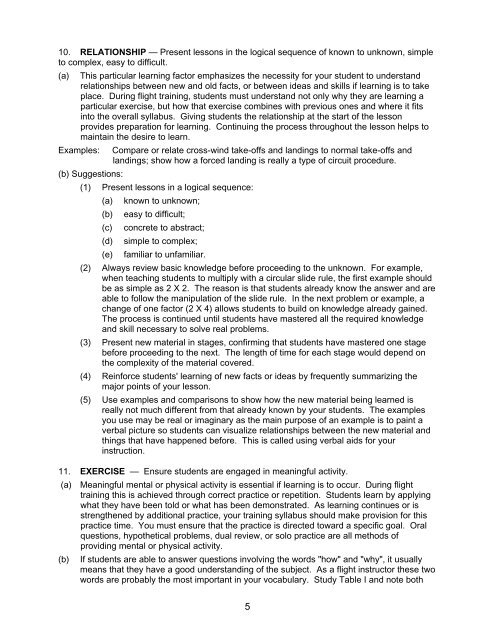FLIGHT INSTRUCTOR GUIDE Aeroplane - South African Civil ...
FLIGHT INSTRUCTOR GUIDE Aeroplane - South African Civil ...
FLIGHT INSTRUCTOR GUIDE Aeroplane - South African Civil ...
You also want an ePaper? Increase the reach of your titles
YUMPU automatically turns print PDFs into web optimized ePapers that Google loves.
10. RELATIONSHIP — Present lessons in the logical sequence of known to unknown, simple<br />
to complex, easy to difficult.<br />
(a) This particular learning factor emphasizes the necessity for your student to understand<br />
relationships between new and old facts, or between ideas and skills if learning is to take<br />
place. During flight training, students must understand not only why they are learning a<br />
particular exercise, but how that exercise combines with previous ones and where it fits<br />
into the overall syllabus. Giving students the relationship at the start of the lesson<br />
provides preparation for learning. Continuing the process throughout the lesson helps to<br />
maintain the desire to learn.<br />
Examples: Compare or relate cross-wind take-offs and landings to normal take-offs and<br />
landings; show how a forced landing is really a type of circuit procedure.<br />
(b) Suggestions:<br />
(1) Present lessons in a logical sequence:<br />
(a) known to unknown;<br />
(b) easy to difficult;<br />
(c) concrete to abstract;<br />
(d) simple to complex;<br />
(e) familiar to unfamiliar.<br />
(2) Always review basic knowledge before proceeding to the unknown. For example,<br />
when teaching students to multiply with a circular slide rule, the first example should<br />
be as simple as 2 X 2. The reason is that students already know the answer and are<br />
able to follow the manipulation of the slide rule. In the next problem or example, a<br />
change of one factor (2 X 4) allows students to build on knowledge already gained.<br />
The process is continued until students have mastered all the required knowledge<br />
and skill necessary to solve real problems.<br />
(3) Present new material in stages, confirming that students have mastered one stage<br />
before proceeding to the next. The length of time for each stage would depend on<br />
the complexity of the material covered.<br />
(4) Reinforce students' learning of new facts or ideas by frequently summarizing the<br />
major points of your lesson.<br />
(5) Use examples and comparisons to show how the new material being learned is<br />
really not much different from that already known by your students. The examples<br />
you use may be real or imaginary as the main purpose of an example is to paint a<br />
verbal picture so students can visualize relationships between the new material and<br />
things that have happened before. This is called using verbal aids for your<br />
instruction.<br />
11. EXERCISE — Ensure students are engaged in meaningful activity.<br />
(a) Meaningful mental or physical activity is essential if learning is to occur. During flight<br />
training this is achieved through correct practice or repetition. Students learn by applying<br />
what they have been told or what has been demonstrated. As learning continues or is<br />
strengthened by additional practice, your training syllabus should make provision for this<br />
practice time. You must ensure that the practice is directed toward a specific goal. Oral<br />
questions, hypothetical problems, dual review, or solo practice are all methods of<br />
providing mental or physical activity.<br />
(b) If students are able to answer questions involving the words "how" and "why", it usually<br />
means that they have a good understanding of the subject. As a flight instructor these two<br />
words are probably the most important in your vocabulary. Study Table I and note both<br />
5













